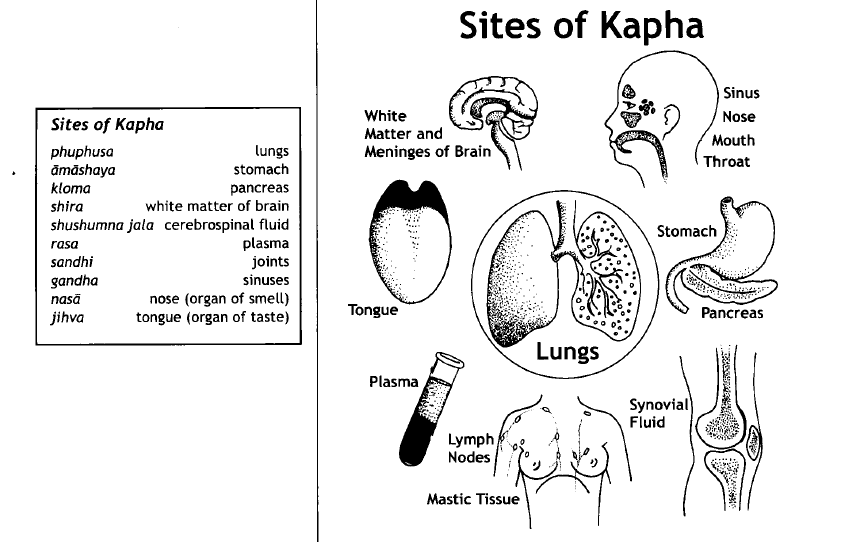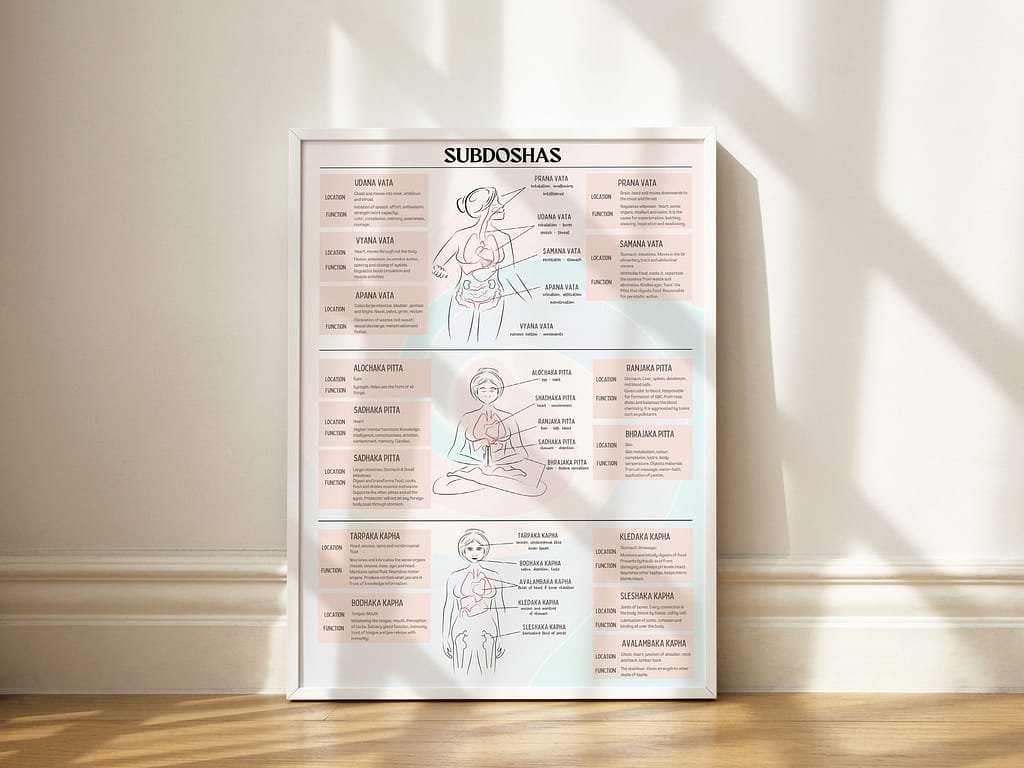The word ‘kapha’ is the combination of ‘ka’ which means water and ‘pha’ which means flourishing. Kapha is that which is flourished by water component. Kapha dosha molecules are a combination of water and earth elements which give it the properties of heaviness, dull, slow, cold, oily, dense, soft, sticky, cloudy and smooth. Kapha is growth promoting and ability to join together. It gives shape and mass and form to the body.
Read more about kapha body types here.
The main sites of kapha are lymph nodes, blood plasma which is more than 90% water, lungs, respiratory tract, semen, fat molecules, white matter of the brain and connective tissue. Anything in the body that has the colour white is kapha.
In one of the previous articles, we discussed about the subtypes of pitta dosha. Similar to that there are also 5 subtypes of kapha dosha namely Kledaka kapha, Avalambaka kapha, Bodhaka kapha, Tarpaka kapha and Shleshaka kapha. Lets discuss why they exist and what are their functions in the body.

Kledaka Kapha
Kledaka kapha is mainly seated in the gastrointestinal tract. It is responsible for kledana which is moistening, softening and liquidation of food. This is done by mixing the food with mucus, so that the food can be broken down and further move inside the gastrointestinal tract. This mucus is kledaka kapha and it is alkaline in nature which also forms a lining in the stomach to protect it from acids that are present for digestion. It also nourishes the rasa dhatu.
When in balanced state, kledaka kapha brings satisfaction and need for lesser food. When in imbalanced or vitiated state, a person eats a large amount of food to feel satisfied, creating a cycle of more eating.
Kledaka kapha disorders include obesity, diabetes, obsessive eating habits, high cholesterol, hyperglycaemia when kledaka kapha is in excess. When it is depleted it creates disorders like hypoglycaemia and peptic ulcers.
Avalambaka Kapha
Avalambaka kapha is present in the respiratory and cardiovascular system. Inside the pleural cavity (empty space inside lungs) it is present as pleural fluid, inside the pericardial space (inside the heart) it is present as pericardial fluid and inside the bronchi and bronchioles, it is present as bronchial secretions.
The main function of avalambaka kapha is to support the functioning of the lungs and the heart. It also support a region called ‘trika’ which means the region from head to shoulder to heart (scapular region to region under pectoralis major muscle).
An inferior quality of avlambaka kapha may create brochitis, asthma, pneumonia, bronchiectasis and emphysema. If this kapha is created in deficit, it can create an imbalance and dryness of fluid in the chest region creating excessive pressure on the heart and lungs. This can cause hypertension, pulmonary tuberculosis, atelectasis collapse of pulmonary alveoli, palpitations, heart rhythm disorders, rupture of pulmonary vessel.

Bodhaka Kapha
Bodhaka kapha is present in the mouth and tongue as saliva and its main function is to have ‘bodh’ or knowledge of 6 tastes. It helps to identify taste, and functions as the first stage of digestion by mixing with food to make to moist. It is liquid, sticky, sweet, and slightly unctuous in nature.
It keeps the mouth wet and keeps the oesophagus lubricated and also helps in clear speech, swallowing and facilitates easy movement of the tongue inside the oral cavity. The agni associated with bodhaka kapha is bodhaka agni and it helps in maintaining the oral temperature.
Bodhaka kapha in form of saliva is sweet in nature and is easily susceptible to bacteria growth. A healthy saliva is thin and unhealthy is thick. Thick saliva can lead to dental calculi, receding gums, worms, diabetes and Parkinson’s disease. Excess production of saliva or thick saliva can be an indicator of dehydration of pre-diabetic conditions.
Tarpaka Kapha
Tarpaka kapha is present in the head and the main function of this type is to provide lubrication to the brain tissue. It is correlated to meninges and cerebrospinal fluid and is present in the white matter of the brain and surrounding the spinal cord. It is also present in the myelin sheath which is a protective sheath around the never cells.
It nourishes the brain cells, and the nerve cells. Its function is to nourish, retain and record hence it is responsible for memory. Inside the spinal cord, it governs the action of the reflexes.
An imbalance of tarpaka kapha creates disorders like paralysis, stroke, Parkinson’s disease, brain tumor, concussion, contusion and loss of memory.
Shleshaka Kapha
Shleshaka kapha is present throughout the body and is specifically found in the joints. It nourishes and lubricates the joints, the cartilage and strengthens and supports the entire skeletal system and ligaments.
It is thick and unctuous in nature the loss of which can create cracking and popping sounds in the joints. Vata enters the joints due to the dry molecules of reduced shleshaka kapha. It then creates pain and stiffness. Excessive and vigorous exercise can also lead to depletion of shleshaka kapha.
The disorders of shleshaka kapha include degenerative and rheumatoid arthritis and sciatica.
| Types of Kapha | Seat | Function |
|---|---|---|
| Kledaka kapha | Stomach; Gastrointestinal Tract | Gastric secretion; digestion and absorption; nourishes rasa |
| Avalambaka kapha | Lungs; Pleural Cavity; Heart; Respiratory Tract; Spine | Support; holds emotions; supports all kapha systems |
| Bodhaka kapha | Oral cavity | Salivary secretions; taste; swallowing; speech |
| Tarpaka kapha | Brain (white matter); Myelin Sheath; Cerebrospinal Fluid | Subconscious thinking and emotions; memory |
| Shleshaka kapha | Joints | Lubricates joints (synovial fluid); nourishes bones |
Did you find this post useful? Would you like to get back to it later? Save THIS PIN below to your Pinterest Natural Living or Ayurveda board!

